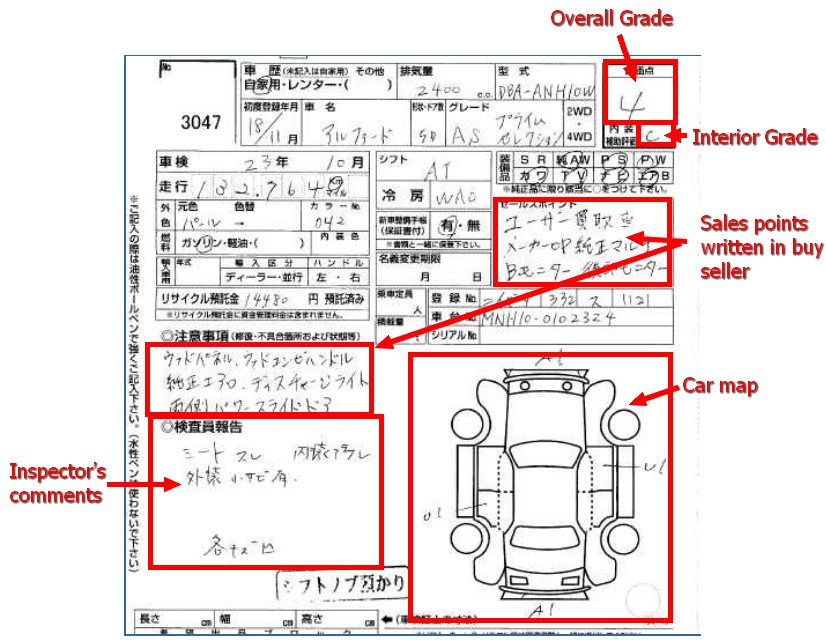Japan Car Auction Sheet Verification in the USA
Japanese cars auction sheet verification is a crucial step for buyers in the USA wishing to import autos from Japan. The auction sheet is a detailed document created by auction houses. That provides a clear summary of a vehicle’s condition, mileage, repairs, and overall grade. It assists purchasers in determining the vehicle’s value and guarantees that the car satisfies expectations. Verifying the auction sheet’s legitimacy is critical to avoiding dangers such as concealed damages, fraudulent documents, or incorrect information. This approach protects purchasers from financial loss and provides a safe, informed purchase.
Verifying the auction sheet’s legitimacy is just as vital as interpreting its contents. Inaccurate or fabricated auction sheets might result in financial losses since they misrepresent the vehicle’s actual condition. For example, a high auction grade car may really contain hidden damage or severe wear that was not revealed on the sheet. This approach finally assures a seamless, transparent, and dependable car-buying experience in Japan.
Recognition of the Japanese Car Auction Sheet:
A Japanese car auction sheet is a document created by expert inspectors at auction houses to assess a vehicle’s condition. These papers are quite thorough, ensuring that customers, particularly international ones, receive precise information prior to purchasing.
Why is Auction Sheet Verification Important?
Auction sheets are the most verifiable source of information regarding a vehicle being sold at auction. However, purchasers in the United States must exercise caution, as bogus auction documents and modified information are very uncommon.
Essential Features of an Auction Sheet:
- Auction House Information:
Each auction sheet is published by a particular auction house, such as USS, JU, or TAA. The auction house’s emblem and name confirm its validity.
- Auction grade:
Cars are assessed according on their general condition.
Grade 5: An automobile that is nearly brand new.
- Grade 4 or 4.5: indicates minimal wear and tear.
- Grade 3 or 3.5: indicates noticeable wear and is suited for budget-conscious buyers.
- Grade R: refers to a car that has been repaired after an accident.
- Mileage (kilometres):
The odometer readout shows how much the car has been used. Always compare the given mileage to the vehicle’s physical condition to confirm correctness.
- Damage and Repair Information:
Symbols and diagrams emphasise any damage, such as dents, scratches, or rust, as well as instructions on replacement parts or repairs.
- Vehicle Specifications:
For accurate identification, the car’s chassis number, year of production, engine type, and colour are mentioned.
Risks Associated with Neglecting Verification:
- Financial loss: Paying a high price for a car with concealed defects or incorrect mileage.
- Safety Concerns: Buying a car with concealed repairs might lead to mechanical faults and pose a safety risk.
- Legal Issues: Importing an automobile with altered documents may cause registration issues.
By affirming the auction document, purchasers can properly appraise the car’s worth and condition, reducing risks.
Steps for Verifying a Japanese Car Auction Sheet

- Acquire the original auction sheet:Always request an auction document from the dealer or importer. A legitimate seller will gladly offer this document. Be cautious if the vendor refuses to share the auction sheet or gives an unclear copy.
- Familiarise yourself with Auction Sheet Details: Understanding how to read an auction sheet is vital. Learn about the grading system, damage symbols, and other important features to effectively assess the car’s condition.
- Use online verification tools:Several internet sites allow bidders to check auction sheets by inputting the vehicle’s chassis number. These tools cross-reference the auction house records to determine whether the document is legitimate.
- Websites for Auction Houses: A few Japanese auction houses offer online access to their records.
- Verification Services: Professional companies in the USA provide accurate verification.
- Inspect the visual condition of the car:If possible, compare the auction sheet information to the actual condition of the vehicle. Give special attention to:
- Odometer mileage.
- Report any observable damages not stated on the form.
- Interior wear and tear.
- Consult experts:If you are unfamiliar with auction documents or the verification process, get assistance from specialists in Japanese car imports. They can detect discrepancies and provide precise information about the car’s condition.
Tips for Safe Acquiring:
- Deal with Reputable Dealers: Pick seasoned importers who have a transparent history.
- Invest in Verification Services: Professional verification is affordable compared to the risks of purchasing a misrepresented vehicle.
- Compare Prices: Make sure you are not overpaying by researching market prices.
- Review the documentation: Thoroughly: Check all details, including the auction sheet, automobile title and import documents.
- Avoid Rushing the Process: Review all available information and ask questions before making a final purchase.
Conclusion:
Verifying Japanese car auction sheets is an important step for buyers in USA to ensure a secure and transparent transaction. The auction sheet provides an accurate assessment of a vehicle’s condition, but its validity must be verified to avoid fraud or hidden flaws. The advantages of owning a premium Japanese car enjoyed by purchasers. Who follow the procedures described in this book. Also exercise caution while navigating the car import process.
